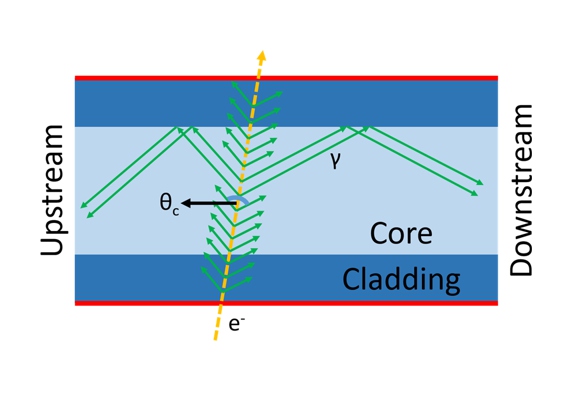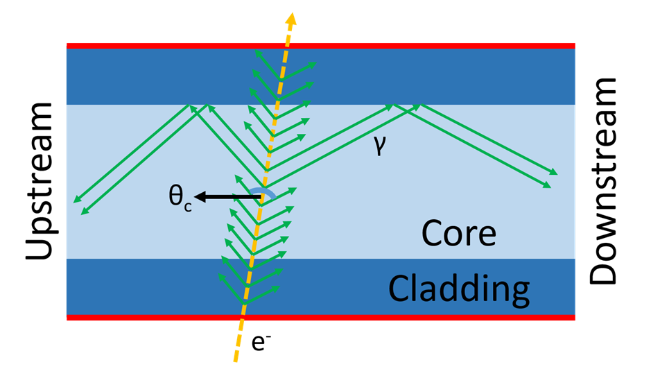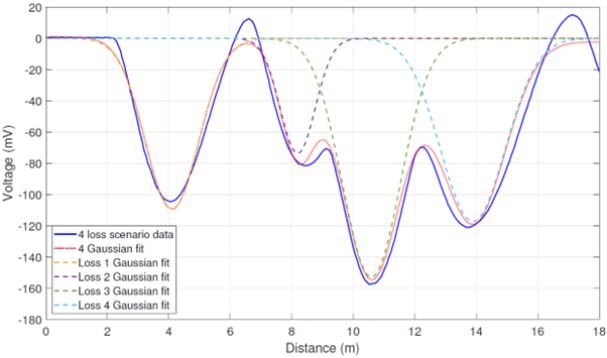Protecting Particle Accelerators with Optical Fibres

Machine protection systems are critical to all particle accelerator infrastructure. Modern accelerators can store extreme energy densities within the particle beam. Anomalous behaviour of a beam can cause excessive radioactive activation of beamline areas, or even damage to accelerator components. Both of these produce additional strain on resources with increased maintenance, hardware turnover, and facility downtime.
Machine protection systems have been developed to counteract these issues. Instrumentation is capable of detecting aberrant behaviour along the beamline on the microsecond scale. This rapid detection allows operators, feedback systems, and other automated processes to correct beam behaviour either by tuning machine settings or dumping the beam to prevent further damage.
Common systems include beam loss monitors. These are devices placed at discrete locations along a beamline which detect beam losses. By far the most utilised are ionisation chambers. These collect the charged particles produced by loss events, and measure the absolute dose created at that location. These devices give excellent measurements at single locations, but the beamline coverage they provide is limited by the number of devices that can be placed on the beamline. Other systems in the machine protection chain focus on the actual accelerating structures of an accelerator and detect radio frequency (RF) breakdown. RF acceleration technology utilises high electric field strengths, which can lead to a process known as RF breakdown. This is where the RF can rip electrons and gas from a surface, eventually creating an electrical short, with an accompanying arc. This arc can cause significant damage. Diagnostics are therefore designed to react as quickly as possible. When breakdown occurs, a significant amount of the input RF power is reflected. Monitoring this reflected power allows operators or automated systems to modulate the RF power into a cavity and prevent a breakdown from causing significant damage. A distinct disadvantage which is inherent to these diagnostics is a breakdown event must occur at a significant level before action can be taken.
As highlighted above, current systems react after an event has begun to cause damage, the devices are independent of one another, with little utilisation of the possible data links and patterns between devices and achieving full facility coverage is resource heavy and time consuming.
 A simplified schematic of the generation, capture, and propagation of Cherenkov radiation in an optical fibre. (Image credit: Wolfenden, J. et al. Sensors 2023, 23, 2248. CC BY 4.0)
A simplified schematic of the generation, capture, and propagation of Cherenkov radiation in an optical fibre. (Image credit: Wolfenden, J. et al. Sensors 2023, 23, 2248. CC BY 4.0)
In an open access paper just published in a Special Issue on ‘Optical Fiber Sensors in Radiation Environments’ of the journal Sensors researchers, led by QUASAR Group member Joe Wolfenden, developed a new machine protection system based on optical fibre technology in an effort to improve and combine existing systems. The sensing medium in this device is the optical fibre itself. Energetic charged particles, produced by losses or RF breakdown, passing through the fibre generate a pulse of Cherenkov radiation, as shown in the schematic above. The light is generated, captured, and propagated by the optical fibre. Time of flight measurements at either end of the optical fibre allow the precise location of the source of the Cherenkov pulse to be measured. The optical fibre is an extended sensor rather than, for example, a relatively compact ionisation chamber. Therefore, as a beam loss monitor, large sections of beamline can be covered, providing continuous monitoring, and no dark spots where losses can be missed.
An example measurement of beam loss is shown below. This work is the first instance of such a device being used to measure two different machine protection-related phenomena, with no modifications required to switch between the two operational modes.

The Cherenkov signal from the optical fibre for a four-loss location scenario, with a four Gaussian fit and the individual loss Gaussian fits. (Image credit: Wolfenden, J. et al. Sensors 2023, 23, 2248. CC BY 4.0)
As the detector output is continuous and the measurement instantaneous, the next stage of this research will focus on developing a smart device. This will utilise machine learning techniques to probe what can be predicted ahead of time, making this a proactive diagnostic rather than a reactive one. With a dedicated, small-scale system, rapid and high sensitivity measurements can occur. This would lead to earlier, smaller mitigation actions for accelerator operators, increasing machine up-time, output, and overall efficacy.
Further information:
Wolfenden, J.; Alexandrova, A.S.; Jackson, F.; Mathisen, S.; Morris, G.; Pacey, T.H.; Kumar, N.; Yadav, M.; Jones, A.; Welsch, C.P. Cherenkov Radiation in Optical Fibres as a Versatile Machine Protection System in Particle Accelerators. Sensors 2023, 23, 2248. https://doi.org/10.3390/s23042248, CC BY 4.0